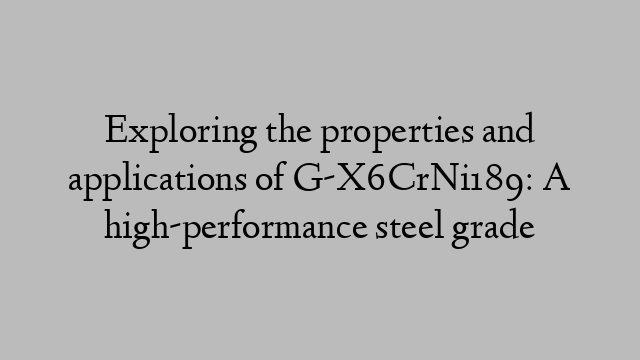Address
304 North Cardinal St.
Dorchester Center, MA 02124
Work Hours
Monday to Friday: 7AM - 7PM
Weekend: 10AM - 5PM
Address
304 North Cardinal St.
Dorchester Center, MA 02124
Work Hours
Monday to Friday: 7AM - 7PM
Weekend: 10AM - 5PM

G-X6CrNi189 is a high-performance steel grade that is most commonly used in the production of stainless steel products. It is known for its excellent mechanical properties and chemical composition.
The mechanical properties of G-X6CrNi189 include:
1. Tensile Strength: The tensile strength of this steel grade is around 550 MPa, which makes it highly resistant to deformation under tension. This property is essential in applications where the steel needs to withstand high loads and stresses.
2. Yield Strength: The yield strength of G-X6CrNi189 is approximately 240 MPa. This property indicates the maximum stress that the steel can withstand before it starts to deform permanently.
3. Elongation at Break: This steel grade exhibits a high elongation at break of up to 35%. This property indicates the ability of the steel to stretch under tension before it breaks.
4. Hardness: G-X6CrNi189 typically has a hardness of around 170-190 HB. This value indicates the steel’s resistance to indentation, wear, and abrasion.
The chemical composition of G-X6CrNi189 includes the following elements:
1. Chromium (Cr): Chromium is the main alloying element in this steel grade, present in a range of 17-19%. It enhances the steel’s corrosion resistance and provides it with its characteristic stainless properties.
2. Nickel (Ni): Nickel is another important alloying element, present in a range of 8-10%. It improves the steel’s resistance to corrosion, especially in acidic environments.
3. Carbon (C): Carbon content in G-X6CrNi189 is limited to a maximum of 0.08%. This low carbon content ensures that the steel remains non-reactive and resistant to carbide precipitation during welding.
4. Manganese (Mn): Manganese is added in a minimal amount, usually below 2%. It improves the steel’s hardenability and facilitates the formation of a protective oxide layer on the steel surface.
5. Other trace elements: G-X6CrNi189 may also contain small amounts of other elements such as silicon (Si), phosphorus (P), sulfur (S), and nitrogen (N), which can affect specific properties and characteristics of the steel.
Applications of G-X6CrNi189:
1. Automotive industry: This steel grade is commonly used in the manufacturing of components for automotive applications such as exhaust systems, mufflers, and fuel tanks. Its corrosion resistance and high-temperature strength make it suitable for these demanding environments.
2. Chemical industry: G-X6CrNi189 is widely used in the chemical industry for equipment and apparatus where resistance to corrosion and high temperatures are required. It is used in the production of storage tanks, pipes, and valves.
3. Food processing industry: This steel grade is commonly used in the production of food processing equipment such as tanks, containers, and piping systems. Its corrosion resistance and hygienic properties make it suitable for contact with food and beverages.
4. Construction industry: G-X6CrNi189 is also used in the construction industry for architectural applications such as building facades, handrails, and decorative elements. Its corrosion resistance and aesthetic appeal make it a popular choice in these applications.
G-X6CrNi189 Steel grade
1698736668